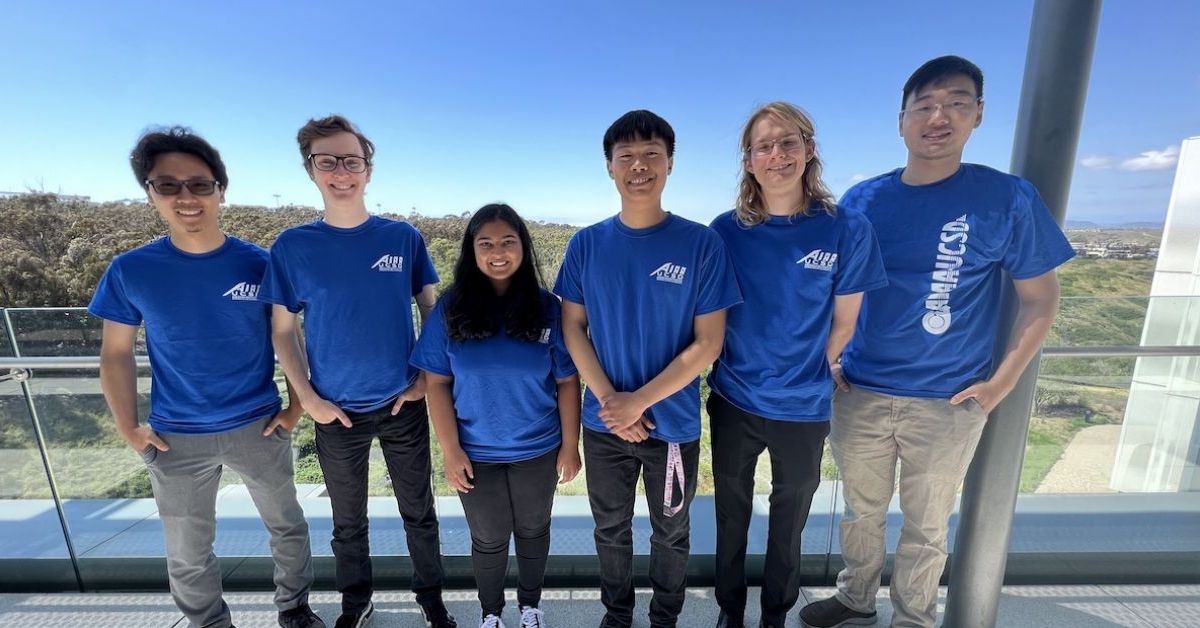Engineering Students Present Laser-Driven Aircraft Propulsion Proposal to NASA
The UC San Diego team is one of eight finalists with big ideas for future aviation energy sources
Story by:
Media contact:
Published Date
Story by:
Media contact:
Share This:
Article Content
A group of undergraduate and masters engineering students from the University of California San Diego has been selected as one of eight finalists in the 2023 Gateways to Blue Skies: Clean Aviation Energy (Blue Skies) Competition. The students will present their ideas for future sources of aviation power to a panel of industry experts at the 2023 Blue Skies Forum, June 1-2, 2023, at NASA’s Glenn Research Center in Cleveland, Ohio, which will be livestreamed globally.
Update: The team emerged victorious with an award for Best Infographic and a second-place finish overall.
The Triton team’s concept, Aircraft Propulsion by Direct Energy Beam Bursts (DEB-B), proposes using targeted lasers as an alternative to solar energy. Ground-based power stations using renewable energy sources will power aircraft using beams of light. These lasers can either recharge batteries or heat air in engines to provide thrust. Eventually, this can be expanded to orbiting space stations.
The project video explains the technical details in a fun and accessible manner and highlight's the team's penchant for intelligent mischief.>
Members of the student team are:
- Josh Cantrell (Junior, Aerospace Engineering at UC San Diego)
- Seth McLaughlin (Junior, Aerospace Engineering)
- Sindhu Perubotla (Sophomore, Aerospace Engineering)
- Brandon Vinh (Junior, Aerospace Engineering)
- Ignatius Widjaja (Graduate Student, Mechanical Engineering)
- Jonathan Zhang (Graduate Student, Mechanical Engineering)
The idea originated from Widjaja’s senior design project, which proposed using similar technology to power unmanned drones in the atmosphere of Venus.
“Finding previous work on the subject and extrapolating how the technology might evolve by the year 2050 has been challenging, but the subject matter has made it a lot of fun,” said McLaughlin. “It's a huge honor to be recognized for our work and we're very excited to represent the university at June's finalist forum."
The 2023 Blue Skies Competition, sponsored by NASA’s Aeronautics Research Mission Directorate (ARMD) and managed by the National Institute of Aerospace (NIA), challenged students to conceptualize the lifecycle of a potential clean energy source that could be used to power aviation in 2050. Teams submitted proposals and videos. The UC San Diego team’s video showcases both the precision and intricacy of the concept and the fun-loving attitude the group bring to its highly demanding work.
"This competition gave us a unique opportunity to contribute to the global effort to combat climate change,” said Perubotla. “It was interesting to see all of our different ideas work together to create our final proposal. It goes to show how creativity and teamwork can create unique solutions to one of the biggest problems that we face."
The project opens new avenues for the students to further their careers in a field full of diverse and exciting challenges and opportunities. “All of us have a personal and professional interest in aerospace engineering, and this competition highlights the depth and breadth of inspirations and possibilities for our careers and the industry as a whole,” said Widjaja.
Sylvia Herbert, a professor of mechanical and aerospace engineering at the University of California San Diego and Principal Investigator at the university’s Safe Autonomous Systems Lab, served as a faculty advisor and mentor for the team. Herbert is also a member of the UC San Diego Contextual Robotics Institute.
“This project was entirely student-driven and all credit should go to their initiative, creativity, and perseverance,” Herbert said. “These students have a very demanding course load (I should know--several of them are currently in my course!), so their skills at time management and teamwork are all the more notable. They are outstanding role models for other aspiring aerospace engineers.”
The competition is part of an international push toward zero-emission aviation by 2050. The eight teams selected as finalists will receive a $6,000 stipend to support their participation. Winning team members earn a chance to intern at one of NASA’s Aeronautics centers in the 2023-24 academic year.
Share This:
Stay in the Know
Keep up with all the latest from UC San Diego. Subscribe to the newsletter today.




